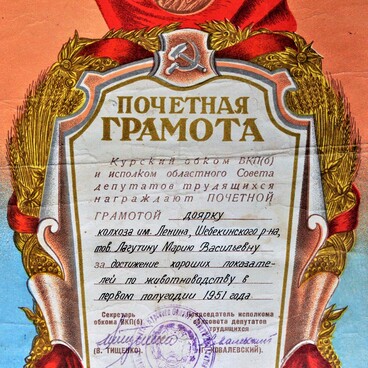“Russian Copy-Book” by Feofil Putsykovich is a study guide of the early 20th century. It was intended for secondary and elementary school pupils. A copy of the workbook was donated to the Shebekino History and Art Museum by Fedor Stepkin, a resident of Starikovo village in the Shebekino district.
For over 20 years, Feofil Putsykovich worked as a teacher in St. Petersburg. Along with that, he was the author of a vast number of textbooks for folk schools on a wide variety of subjects. Among them are “The Short History of Russia”, “The Russian Spelling Lessons”, “The Russian Alphabet”, “The Russian-Slavic Alphabet”, “The Practical Russian Grammar”, “Geography for Elementary Schools”, and many others. “Russian Copy-Book” is only one of his works.
In the early 20th century, “The Scripture” was the main subject in the public education system — studies of the Orthodoxy keystone. Putsykovich compiled and prepared for publication an illustrated series of “Bible Stories”, approved for public reading by the Education Committee under the Holy Synod. It included pamphlets “The Creation”, “The Patriarchs–Ancestry”, “Solomon”, “Ruth”, “Joshua”, “The Ancient Prophets”, “Judas Maccabeus”, etc. The cost of the book was affordable to all — from 4 to 8 kopecks, cheaper than butter or 10 kilograms of flour.
Another Putsykovich’s book series — “From Ethnology” — was permitted by the Ministry of Public Instruction for use in student libraries of all lower educational institutions, and in public reading rooms as well. It consisted of 40 editions. Each one was a description of a separate nation: “Bohemians”, “Rusyns”, “Persians”, “Gypsies”, “Greeks”, “Englishmen”, etc.
Feofil Putsikovich’s book “The Life of Our Lord Jesus Christ, World’s Savior” was republished many times. It was a biography of Jesus Christ, which the author compiled from available sources, and briefly described the fate of the Savior. Putsykovich intended the edition to be a “table book for the family and school”, but the Scientific Committee under General Staff recommended it for mass use: for those serving in the army.
For over 20 years, Feofil Putsykovich worked as a teacher in St. Petersburg. Along with that, he was the author of a vast number of textbooks for folk schools on a wide variety of subjects. Among them are “The Short History of Russia”, “The Russian Spelling Lessons”, “The Russian Alphabet”, “The Russian-Slavic Alphabet”, “The Practical Russian Grammar”, “Geography for Elementary Schools”, and many others. “Russian Copy-Book” is only one of his works.
In the early 20th century, “The Scripture” was the main subject in the public education system — studies of the Orthodoxy keystone. Putsykovich compiled and prepared for publication an illustrated series of “Bible Stories”, approved for public reading by the Education Committee under the Holy Synod. It included pamphlets “The Creation”, “The Patriarchs–Ancestry”, “Solomon”, “Ruth”, “Joshua”, “The Ancient Prophets”, “Judas Maccabeus”, etc. The cost of the book was affordable to all — from 4 to 8 kopecks, cheaper than butter or 10 kilograms of flour.
Another Putsykovich’s book series — “From Ethnology” — was permitted by the Ministry of Public Instruction for use in student libraries of all lower educational institutions, and in public reading rooms as well. It consisted of 40 editions. Each one was a description of a separate nation: “Bohemians”, “Rusyns”, “Persians”, “Gypsies”, “Greeks”, “Englishmen”, etc.
Feofil Putsikovich’s book “The Life of Our Lord Jesus Christ, World’s Savior” was republished many times. It was a biography of Jesus Christ, which the author compiled from available sources, and briefly described the fate of the Savior. Putsykovich intended the edition to be a “table book for the family and school”, but the Scientific Committee under General Staff recommended it for mass use: for those serving in the army.


